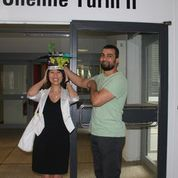Dr. Xin Guan
Current address
- Dr. Xin GUAN
- College of Horticulture and Landscape Architecture
- Southwest University, Tianshenglu 2, Beibei, 400700, Chongqing, China, Postcode 400700
- Tel: +86-(0)-23-6825-1047 (Office)
- e-mail xinguan cnde ∂does-not-exist.googlemail com
- website
Ph.D. thesis: Guan, Xin (2013) Functional Analysis of Cytoskeletal Signalling in the Defence Response of Grapevine
Xin Guan joined the group in 2010 with a fellowship of the prestigious Chinese Scholarship Council. She investigated the role of the cytoskeleton for the response of plant cells to pathogen attack. In cooperation with the group of Dr. Günther Buchholz, AlPlanta, Neustadt, she succeeded to generate transgenic grapes, where the cytoskeleton was labelled by the Green Fluorescent Protein from the jellyfish Aequorea. This allowed her to observe, how actin filaments (the muscle fibres of plant cells) disassemble, when a flagellated spore of Downy Mildew attaches at the guard cell. Not only this: even the other cells of the leaf surface show the same response, although they did not experience any direct contact with the pathogen. Also for the second system of the plant cytoskeleton, the microtubules, she was able to generate a grapevine cell line, where the microtubules are fluorescent. Using this tool, she was able to demonstrate that microtubules not only respond to salt or cold stress, but also to the plant stress hormone jasmonate.
Publications from her Ph.D.
- Guan X, Buchholz G, Nick P (2013) The cytoskeleton is disrupted by the bacterial effector HrpZ, but not by the bacterial PAMP flg22 in tobacco BY-2 cells. J Exp Bot 64, 1805-1816 - pdf
- Guan X, Buchholz G, Nick P (2014) Actin marker lines in grapevine reveal a gatekeeper function of guard cells. J Plant Physiol 171, 1164–1173 - pdf
- Guan X, Buchholz G, Nick P (2015) Tubulin marker line of grapevine suspension cells as a tool to follow early stress responses. J Plant Phys 176, 118-128 - pdf
Current research
After her Ph.D., Dr. Xin Guan moved as postdoc to the Université de Haute-Alsace in Colmar and worked on the cellular aspects of grapevine diseases that are caused by wood-decaying fungi. This research was integrated into the research network Bacchus - Research for Sustainable Viticulture, funded by the Interreg Upper Rhine. In this context, she compared different grape varieties, but also wild grapes, among others some of our wild grapes raised in the collection of our Botanical Garden. She revealed that some wild grapes (Vitis sylvestris, the ancestor of our domesticated grapevine) were resistant against wood-decaying fungi. This allows, therefore, to breed, by crossing these wild grapes, new varieties, that can cope with these diseases. Due to global warming, these diseases spread currently also in France and Germany. In the past, they were contained by arsenic, but for good reasons, this is not allowed any longer in Europe. The research by Dr. Guan indicates that there exist alternative, ecologically safe pathways to control this disease.
After her postdoc, she returend to China, where she got an assistance professor position at the Southwest University in Chongjing. Here as well, she remained linked with the topic genetic resources from crop wild relatives. This time, she works on Citrus species. This genus has been domesticated in Southwest China, where there is also the diversity centre. Some of the wild Citrus species are used in the elaborate system of Traditional Chinese Medicine, among others to treat tumours. In a cooperative projects, extracts from different Citrus species were screened for a potential activity against microtubules, and from the comparison between compounds and biological activity, different molecular candidates were identfied. Among those, the secondary compound gallic acid was analysed in more detail. In cooperation with the Institute for Toxikology and Genetics (ITG, AG Prof. Dr. Ute Schepers) team member Si Tan from Dr. Xin's lab (by the way also funded by the Chinese Scholarship Council) could demonstrate that gallic acid can induced apoptosis, a kind of cellular suicide, in HeLa cancer cells. A closer investigation uncovered that this was linked with abnormal cell divisions, where microtubules were assembled in division spindles with three or even four polse, such that the chromosomes of these cancer cells were distributed unequally, such that the cell died soon. The reason for this effect is that cancer cells due to their abnormity generate several centrioles (these are the organisation centers for the division spindles), but that they "glue" these centrioles together, such that they still can form a functional spindle This "glueing" is disrupted by gallic acid. The good point: healthy cells harbour only two centrioles, and therefore do not need to "glue" anything, such that they are not affected by gallic acid.
Publication on wood decaying fungi
118. Guan X, Essaki H, Laloue H, Nick P, Bertsch C, Chong J (2016) Mining new resources for grape resistance against Botryosphaeriaceae: a focus on Vitis vinifera ssp. sylvestris. Plant Pathol 65, 273-284 - pdf
Publications on active compounds from wild Citrus
119. Tan S, Grün C, Guan X, Zhou Z, Schepers U, Nick P (2015) Gallic acid induces mitotic catastrophe and inhibits centrosomal clustering in HeLa cells. J Toxicol in vitro 30, 506-513 - pdf
126. Guan X, Tan S, Zhou Z Buchholz G, Nick P (2016) Mining secondary metabolites with microtubular activity in fruit extracts of Chinese wild Citrus. J Integr Agriculture in press, 24.08.2016


